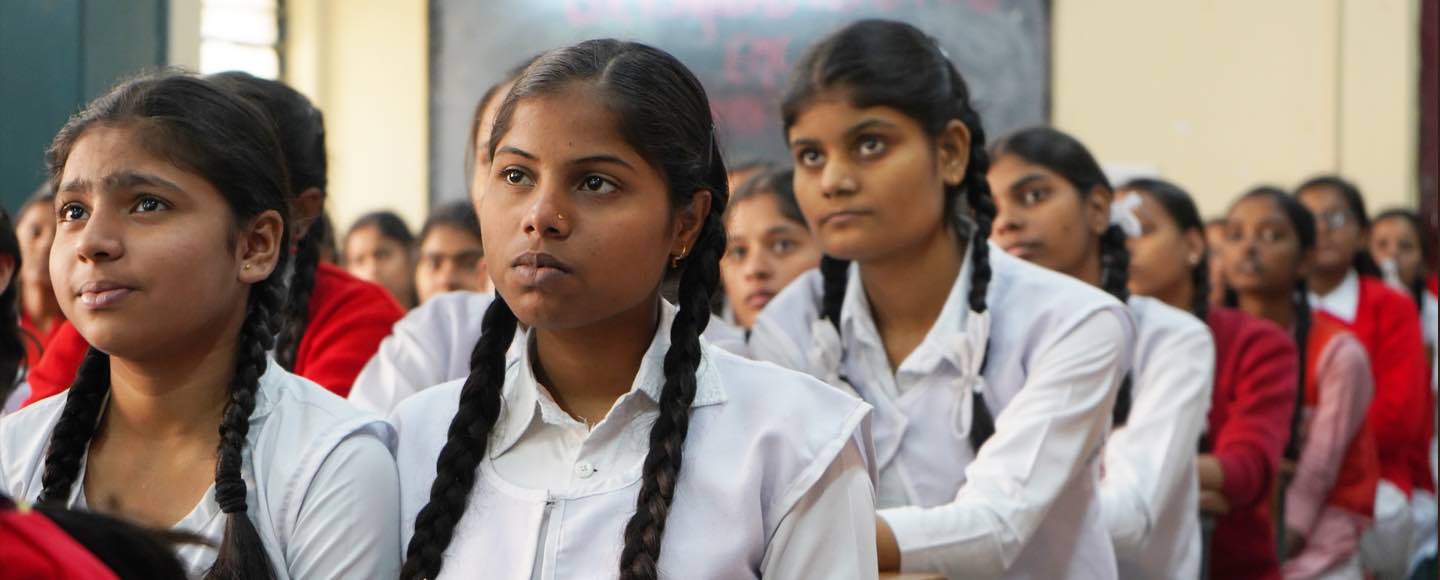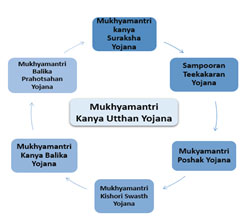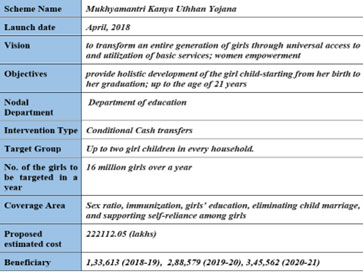
Abstract:
Education, irrespective of gender, plays a crucial role in developing any nation or state. In this context, it has become one of the major concerns for the Indian Government with its commitment to a $5 trillion economy. However, the NFHS-5 data indicates stark realities regarding female education, especially in Bihar. While every state in the country has improved its overall literacy, Bihar remains at the bottom of the list. Therefore, the policy brief seeks to envision the state-specific causes that result in the low participation of females in the education system, along with various policy interventions by the Bihar government with special reference to Mukhyamantri Kanya Utthan Yojana.
Objective:
The brief aims to address the issue of female illiteracy in Bihar by identifying the state-specific causes that lead to the severity of the issue. It further aims to explain the Policy Interventions undertaken by the Bihar government, followed by recommendations.
Introduction:
India is at a stage where it is aiming to achieve a $5 trillion economy, and till now, it has managed the initial headway. However, there are greater chances that it will fizzle out if the bottom of the pyramid, which is more than 50% oIndia's population (female population), does not manage to onboard the economic train. We will be missing out on the potential of more than half of the population if wwon't leverage female talents to achieve our dream. Moreover, many researches have shown that female literacy is a critical aspect of overall development and has a multiplier effect on the economy. Despite having such a value addition, female literacy is abysmally low in rural areas and many pockets of urban areas. Therefore, ensuring the more inclusive participation of women in the education system and, thus, in the workforce should be our next immediate step towards ensuring a growing healthy economy.
Key data analysis of Bihar:
Once known as the storehouse of knowledge, with universities like Nalanada, Takshila, and Vikramshila, Bihar has become one of India's poorest and illiterate states. As per the 2011 census, it stood at the last position in terms of literacy with an overall percentage of 61.80%, i.e. almost 12 points less compared to the national average of 74.04% and 33 points less compared to the most literate state in India (Kerela)1. The male literacy rate in Bihar in 2011 stood at 70%, whereas female literacy was just over 50%, indicating that almost half of the women were outside the ambit of literacy 2. It brings us to the grave issue of gender disparity that becomes more prominent in rural areas, female literacy stands at only 29.6% compared to male literacy of 57.1% in 20113.
Gender disparity in literacy remains the hallmark of the Bihar education system, which was 19.7 points in 2011 4. It also got reiterated in the latest NFHS -5 data that revealed that in Bihar, women's literacy rate is 55% compared to 76.4% in men, aged between 15 to 49 years5. It marks the progress in literacy rates in Bihar but also highlights the gender gap of 21.4 points, which demands immediate attention from not only the state and centre but also civil society.
State-specific causes related to Female illiteracy:
The issue of female literacy is not new to India, but takes a severe face when it comes to a state like Bihar. The socioeconomic contours of the state play a significant role in influencing the decisions toward girls' education. As per my understanding, three factors specific to Bihar have a significant influence on the literacy of females:
Poverty: Bihar is the poorest state in India compared to other states with comparatively more resources 6. The prevalence of multi-dimensional poverty makes it difficult for the populace to prioritise basic needs like education, health care, and food. Owing to the cost of education, it becomes the least essential necessity for low-income families. Subsequently, if families cannot afford school costs, they are more likely to send boys than girls. Therefore, it becomes the main factor determining whether a girl can access education, which is very well reflected in a state like Bihar. Also, it has been seen by many researchers that girls living in poor households are twice as likely to drop out of school as compared to girls in wealthier households. 7
Early marriages : are one of the most common reasons a girl might stop going to school, which also stands true in Bihar's case. As Bihar witnesses the highest rates of child marriage (40%) 8, it loses the equivalent potential in domestic chores and childbearing. Furthermore, NFHS 5 data shows girls who should be pursuing education (15-19 years) are found to be getting married and having children at that age 9. Overall, Bihar reports 11% of teenage pregnancies compared to the national average of 6.8%,which directly relates to girls dropping out of school. 10 As in Bihar, it is generally believed that the dowry to be given is lesser in the case of the younger girl as the family has leverage to bargain with the youthful years of girls. 11 Also, a kind of inverse relation is found between the level of education of girls and the proposals for marriages, thus creating a hostile environment for the higher education of girls. 12
Inadequate access to Menstrual Hygiene Management (MHM): Non-affordability of sanitary products, non-availability of clean sanitation, and the lack of awareness deter female literacy in Bihar. NFHS-5, Bihar records the lowest use of hygienic menstrual practices, i.e. only 59% of its total female population, thus stifling thefemales'' choices.13 According to research, in states like Kerala and Karnataka, where women have more access to hygienic methods of menstrual protection, have completed more than 12 years of education as compared to the states like Bihar and Jharkhand, where there is less awareness about menstrual hygiene. Thus, presenting an interesting correlation between the use of hygienic protection methods and longer stay in school. 14
All these factors together limit the rights of females over their own lives, thus making them the prey of the long-run traditional structure. To empower them- to overcome the hurdles, support from the government in the form of policy intervention and civil society in the form of awareness is needed.
Policy Interventions by the Government of Bihar (GoB):
Endeavours by the Government of Bihar to women's empowerment are giving indications of political will and positive change. By undertaking several pioneering measures for women, Bihar is rowing to becoming a trendsetter for other states. It can be observed with its step to provide 50 % reservation for women in Panchayati Raj Institutions and Urban Bodies that laid the foundation for a social revolution. The revolution, which is supplemented by several novel schemes and policy initiatives-Mukhyamantri Balika Cycle Yojana, Mukhyamantri Balika Poshak Yojana, Mukhyamantri Akshar Aanchal Yojana, of which Mukhyamantri Kanya Uthhan Yojana occupies a distinct place in the female literacy schemes. 
Mukhyamantri Kanya Uthhan Yojana (MKUY):
The scheme, launched in April 2018, received comprehensive coverage that can potentially improve women's conditions. The focus of the schemes can be traced back to the government's commitment to improving women's development indicators and employment opportunities involving seven resolves. 15 It is a game-changer scheme that encompasses the life cycle approach and is universal. Features of the scheme that makes it unique:
1. The holistic approach: From the birth of the girl child till her graduation, the scheme aims to provide financial assistance of Rs.54,100. The monetary aid of Rs 10,000, upon clearing the intermediate level, will be provided to the girl child as an encouragement to enrol in graduation. Subsequently, upon completion of her graduation, a reward amount of ?25,000 shall be given. The financial aid in different tranches across her life stages will suitably work as a preventive measure against the possibility of dropping out due to the cost of ducation.

2. Inclusive approach: The scheme has no limitations and is inclusive as it is not based on caste, income, or even religion. Thus, making the program genuinely universal, unlike other schemes that mainly target marginalised students.
3. Menstrual health: No scheme has before addressed the issue of menstrual health management in education as MKUY did. It not only addresses but also takes a concrete step toward ensuring it. The scheme provides Rs 300 per year to each girl child from class 7th to 12th to ensure hygiene during the menstrual days.
Overall, the scheme's intrinsic potential necessitates completing adult education in girls. It works as a preventive measure against dropping out due to poverty, marriages, and menstrual issues by providing cash transfers, ensuring the condition of being unmarried on completing class 12 and providing financial assistance for sanitary napkins.
Recommendations:
Way Forward:
Bihar Government has taken considerable strides in female literacy through its concentrated efforts. The number of 15-16-year-old girls not enrolled in schools has fallen to 6.7% in 2022 from 28.2% in 2006, as per the ASER Report 2022.16 However, there is a long way to go to achieve a decent female literacy level. Owing to its distinct socioeconomic contours, Bihar Government should adopt a mixed approach of policy and behavioural interventions to bring real effective change into effect. Through such an approach, it must work on the three main issues of poverty, early marriages, and menstruation to ace its efforts in women's empowerment. Furthermore, our dream of a developed and prosperous India will only be realised if we break down gender silos to leverage the strengths of every member of our human resource pool.
____________________
